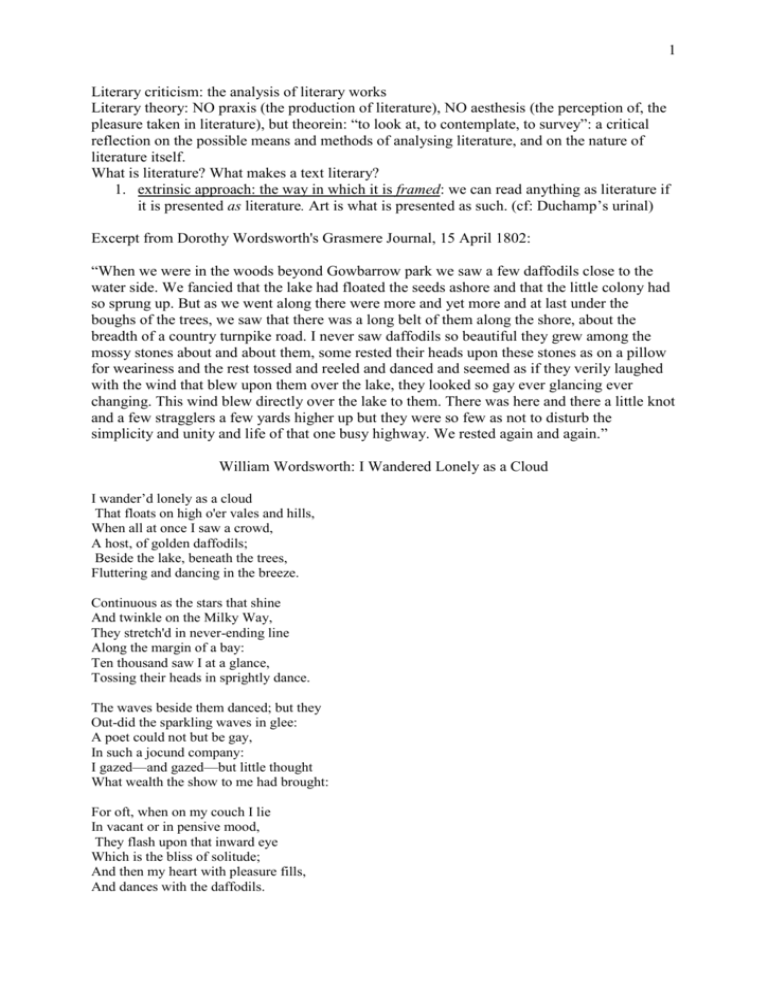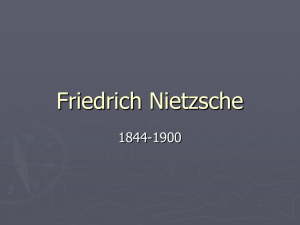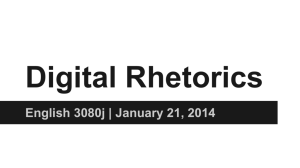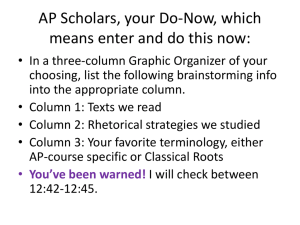Literature, the Literary, Rhetorics
advertisement

1 Literary criticism: the analysis of literary works Literary theory: NO praxis (the production of literature), NO aesthesis (the perception of, the pleasure taken in literature), but theorein: “to look at, to contemplate, to survey”: a critical reflection on the possible means and methods of analysing literature, and on the nature of literature itself. What is literature? What makes a text literary? 1. extrinsic approach: the way in which it is framed: we can read anything as literature if it is presented as literature. Art is what is presented as such. (cf: Duchamp’s urinal) Excerpt from Dorothy Wordsworth's Grasmere Journal, 15 April 1802: “When we were in the woods beyond Gowbarrow park we saw a few daffodils close to the water side. We fancied that the lake had floated the seeds ashore and that the little colony had so sprung up. But as we went along there were more and yet more and at last under the boughs of the trees, we saw that there was a long belt of them along the shore, about the breadth of a country turnpike road. I never saw daffodils so beautiful they grew among the mossy stones about and about them, some rested their heads upon these stones as on a pillow for weariness and the rest tossed and reeled and danced and seemed as if they verily laughed with the wind that blew upon them over the lake, they looked so gay ever glancing ever changing. This wind blew directly over the lake to them. There was here and there a little knot and a few stragglers a few yards higher up but they were so few as not to disturb the simplicity and unity and life of that one busy highway. We rested again and again.” William Wordsworth: I Wandered Lonely as a Cloud I wander’d lonely as a cloud That floats on high o'er vales and hills, When all at once I saw a crowd, A host, of golden daffodils; Beside the lake, beneath the trees, Fluttering and dancing in the breeze. Continuous as the stars that shine And twinkle on the Milky Way, They stretch'd in never-ending line Along the margin of a bay: Ten thousand saw I at a glance, Tossing their heads in sprightly dance. The waves beside them danced; but they Out-did the sparkling waves in glee: A poet could not but be gay, In such a jocund company: I gazed—and gazed—but little thought What wealth the show to me had brought: For oft, when on my couch I lie In vacant or in pensive mood, They flash upon that inward eye Which is the bliss of solitude; And then my heart with pleasure fills, And dances with the daffodils. 2 Dorothy’s journal has literary qualities, and yet, it was not presented as poetry, it was not published anywhere in its own time. Rise of feminist criticism -> canonised as a literary text in its own right -> The Journal is published, and thoroughly edited, and extracts appear in Romantic anthologies. -> It is “institutionalised” as literature <- literature is an institution with publishing houses, editors, reviewers, critics, school and university syllabi-> 1. literature must be framed as literature (it has to look like literature – i.e. a poem never published is also literature) 2. the institutional network (a set of discourses) creates it as an object that counts as literature (canonisation) What do we mean by “literary qualities”? 2. Intrinsic approach: a.) literariness of literature: language drawing attention to itself – language is not a transparent medium to convey a piece of information or a message – the emphasis is on “how” rather than “what” (i.e. the “how” complicates the “what”, makes it more complex, even ambiguous) We do not read “Westminster Bridge” as part of a tourist guide that gives us information about London, nor do we read Ww’s poem as a tourist guide about the Lake District. Lit. is not a piece of information about a reality “behind” it. e.g. “We arrive from the Big Town. We have been travelling all night. Mother’s eyes are red.” (Agota Kristof: The Notebook – first sentences) Language draws attention to itself by making us ask: who are these “we”? What is the reason for this strange, first person plural narration, what does it convey? What is the reason why these “we” do not specify the name of the town where they come from? Why do they say that mother’s eyes are red, rather than saying that mother was crying? Why do they omit reference to feelings? However: everything can be read as literature, if the reader focuses on literariness – i.e. literature is literature because it is read as such. e.g. “Dogs must be carried on the escalator” – ambiguity of the sentence ->language drawn into the foreground by the reader who notices or focuses on this ambiguity -> Is literature a way of reading? (e.g. Derrida reads Plato, the philosopher, or Locke, the philosopher by focusing on language, on “rhetorics”, the ambiguity inherent in the language of the text, rather than on what it wants to “convey”, rather than on some “truth” “behind” it.) b.) performative function of literature Constative: descriptive truth claims, can be falsified or verified. vs: Performative: language creates a change in the existing state of affairs, language creates new things out of nothing. (e.g. “Let there be light!”, “I now pronounce you man and wife.”) [this opposition, introduced by J. L. Austin, is later challenged by Derrida] literature is imaginative writing in the sense that it has a performative function. We do not ask whether Ww really saw the daffodils, or whether Moll Flanders was a living person. However: so that we do not ask these questions, the piece of writing has to be presented, framed as literature.<- no utterance is entirely constative, each text contains performative elements – even history books e.g. Hayden White: The Content of the Form: Narrative Discourse and Historical Representation (1987) – there are no “facts” in history, history is the interpretation of (chaotic, homogeneous) facts, which are presented in a 3 narrative form that gives them coherence, logic and meaning. History writing is performative - it endows facts with a meaning, a hierarchical structure and a plot that are not necessarily there at the first place. If it is difficult to tell fiction and history apart, the “performativity”, or “imaginative character” of literature needs to be supplemented by another criterion-> c.) literature is “discourse that knows of its own fictionality” 3. Intertextuality: literature always inscribes itself into “literature” – works are made out of other works that they repeat, challenge and transform. A work exists through its relation to other works. E.g. Shakespeare’s “My Mistress’ eyes are nothing like the sun” reacts to the Platonic idealisation of women in the poetry of the period (cf. later: T.S. Eliot: “Tradition and Individual Talent”, Harold Bloom: The Anxiety of Influence) All in all: there is no absolute criterion that would define “literature” – literature is the thing that escapes all definitions, all categories - however, the “autonomy” of lit. has much to do with the rise of aesthetics as a separate discipline in the 18th c. – literature is sth. that we read for its own sake (see later! esp. Kant) Singularity of literature? What is good literature? (facts-> value) cf: Derek Attridge: The Singularity of Literature (2004) -> aesthetic + ethical function (see later: ethical criticism) originality and invention: - challenge to accepted cultural norms (both past and present – e.g. women have to get married, or, novels present a linear story) - contains an element of surprise (for every age) -> remains endlessly open to reinterpretation, generates new questions -> - worthy to be reread (exact repetition never occurs with rereading), remains new and challenging at each reading - one can never say this book or that poem “means” or “says” this or that (there is no closure) “I still believe that no good joke is ever racist. And I believe it for the same reasons that I believe no good play or novel is ever racist, regardless of the politics of its author. The discourse of racism is bald, monotonous, unquestioning, single-voiced and desolate. Art, when it is good... is none of those things. Art is dramatic, and by dramatic I mean that it holds everything in opposition and suspense. / The moment art forgets it is dramatic and grows tendentious, the moment it begins to formulate a programme for the amelioration of mankind, or for spreading faith of disbelief, or for promoting racial disquiet or racial harmony, it ceases to be art. Call it a little novel, comprising voices at intellectual and moral odds with one another, taking you by surprise and told, vertiginously, by a narrator it would not be wise of you to trust.” (Howard Jacobson, qtd. by Stephen Mulhall, in The Wounded Animal, J.M, Coetzee & the Difficulty of Reality in Literature & Philosophy, 2009.) What are the characteristics of good art? What are the characteristics of bad art? What kind of binary oppositions organise this passage? THE RISE OF ENGLISH Literature: new concept, emerges in the 18th c (before: everything related to letters and books) English: new discipline, emerges in the last decades of the 19th century, established as a subject after Word War I. 4 Beginnings (not yet “literature”!!): RHETORIC: originally: the art of persuasion (today, we tend to see it as a characteristic of poetry or literature in general -> cf: Dorothy Ww’s Journal, or Ww’s “I wandered lonely”) Gorgias’s school of rhetoric in Athens: Gorgias defends the irresistible power of poetic discourse to arouse emotion and thus control the opinions (doxai) of the audience. Teaches the strategies of style that effect persuasion—antithesis, alliteration, parallelism, etc—and practices these strategies in his own oratory -> (political, social) use value Plato (427-347 BC): rejects rhetoric as the enemy of truth + it has such a strong hold on the human mind that it precludes rational thinking -> it is dangerous for the Republic (->banning of the poets from the Republic) [cf. later: populist speakers->fanaticism in French. Rev. – subversive of est. order] Aristotle (384-322 BC): Rhetoric: authorises rhetoric as an art in its own right. It can be used for good or bad purposes; it can cause great benefits as well as great harms. [Aristotle’s Poetics – concerned with drama - is not yet an analysis of “literature” – poetry is different from history in its focus on the general and the potential rather than the particular and the actual, yet, it is very much embedded in other kinds of discourses. “Aesthetics” (as the study of the beautiful, as the philosophy of art) is not yet considered to be a separate discipline of philosophy.!] Quintilian: Institutio Oratoria Cicero: De Inventione, De Oratore Middle Ages: rhetorics taught at universities – the study of persuasion (the production of arguments “invention”, and the presentation of arguments “dispositio), through the analysis of verbal schemes and tropes, that is, through rhetorical figures, or figures of speech.(incl. metaphor, metonymy, irony, repetition, intensification, etc.) It forms part of the trivium, together with logic and grammar. The art of rehetorics not only contains the teaching of language skills, but case-studies for proper and improper human conduct, and examples to virtue to be imitated. So it also has an ethical function. John Locke: dismissal of rhetorics as an enemy of philosophical truth. (Plato->Locke: rhetorics vs. truth): An Essay Concerning Human Understanding (1690), “On the abuse of Words” „if we would speak of things as they are, we must allow that all the art of rhetoric, besides order and clearness; all the artificial and figurative application of words eloquence hath invented, are for nothing else but to insinuate wrong ideas, move the passions, and thereby mislead the judgment; and so indeed are perfect cheats: and therefore, however laudable or allowable oratory may render them in harangues and popular addresses, they are certainly, in all discourses that pretend to inform or instruct, wholly to be avoided; and where truth and knowledge are concerned, cannot but be thought a great fault, either of the language or person that makes use of them. What and how various they are, will be superfluous here to take notice; the books of rhetoric which abound in the world, will instruct those who want to be informed: only I cannot but observe how little the preservation and improvement of truth and knowledge is the care and concern of mankind; since the arts of fallacy are endowed and preferred. It is evident how much men love to deceive and be deceived, since rhetoric, that powerful instrument of error and deceit, has its established professors, is publicly taught, and has always been had in great reputation: and I doubt not but it will be thought great boldness, if not brutality, in me to have said thus much against it. Eloquence, like the fair sex, has too prevailing beauties in it to suffer itself ever to be spoken against. And it is in vain to find fault with those arts of deceiving, wherein men find pleasure to be deceived.” rhetorics (figures of speech, such as metaphors, metonymies, similes, etc) are the enemy of truth -> in order to convey truth, we have to use literal, ordinary language. Digression: deconstruction of rhetorics in post-structuralist literary theory (late 20th c) 5 Derrida’s deconstructive reading (D. reads Locke as literature, by focusing on language - as against what he says (i.e. metaphors are the enemies of truth), he focuses on the how): Locke’s language is highly rhetorical: he uses metaphors, such as the metaphor of the tabula rasa (white sheet) to represent the human mind at its birth. He equally uses in the above passage a most prominent simile: eloquence is like the fair sex. -> D’s conclusion: there is no language without metaphors (i.e. without rhetorics) - such words as “reflection”, “revolution”, “to grasp the truth”, “the heart of the matter” are all metaphorical. The processes of metaphor are everywhere “at work” (!) in language. Metaphors are “woven into” (!) the very “fabric” (!) of language -> all language is inherently metaphorical and figurative, and figures of speech are not just ornaments. <- influenced by Nietzsche Nietzsche: On Truth and Lie in an Extra Moral Sense (1873) “What is truth?” “A moving army of metaphors, metonymies and athropomorphisms, in short a summa of human relationships that are being poetically and rhetorically sublimated, transposed, and beautified until, after long and repeated use, a people considers them as solid, canonical, and unavoidable. Truths are illusions whose illusionary nature has been forgotten, metaphors that have been used up and have lost their imprint and that now operate as mere metal, no longer as coins.” Truth is constituted by rhetorical figures. Further, these rhetorical figures form an army, so there is something powerful and violent in them. -> “will to power” (cf. later: Foucault) What do they have to do with truth? Nietzsche argues that the language of Western metaphysics is replete with rhetorical figures: philosophers “grasp” a problem, “bring the truth to light”, “enlighten” and “reflect” upon certain things (light usually stands for knowledge and truth.) Also, we tend to anthropomorphise things as if they were similar to us: the leg of the table, the arm of the clock, the heart of the problem or matter, or God itself –> as if we, human beings were the centre of the universe ->the universe becomes a humancentred set of meanings. -> we constitute truth with language, and do not describe it. -> performative dimension of language. If rhetorical figures are constitutive of the world (they shape it, and endow it with the coherence that it lacks), and they cannot be escaped, then is there any difference between “literary” (rhetorical) and “ordinary” (or philosophical) language? Nietzsche: human-centeredness, the subjective interpretation of the world is not truth but an illusion. Yet this is an illusion the illusionary nature of which has been forgotten – we use metaphors and antropomorphisms without being aware of it, and we do not know that the illusion they give of order and coherence is a lie. Yet, there is no other way: 1.) it is impossible to devise a language that would be devoid of rhetorical figures. 2.) language inescapably constitutes the reality around us. -> as opposed to Locke, Nietzsche argues that there is no opposition, no difference between philosophical language that is supposed to convey the truth on the one hand, and literary language, or rhetorics that Locke dismisses as lie on the other. All language, even the language of philosophy is metaphorical, and is constitutive (rather than descriptive) of truth. -> influence on deconstruction: there is a gap between “reality” and “language”-> language constitutes truth and there is no way to “grasp” or “express” “reality”. I.e. language precedes reality. Paul Ricoeur: The Rule of Metaphor (1975): inherent metaphoricity of language + metaphors redescribe and reshape reality, they create new insights and new meanings-> a happy thing!





